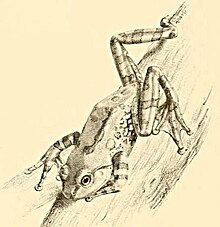Ghatixalus variabilis
| Ghatixalus variabilis | |
|---|---|

| |
| Scientific classification | |
| Domain: | Eukaryota |
| Kingdom: | Animalia |
| Phylum: | Chordata |
| Class: | Amphibia |
| Order: | Anura |
| Family: | Rhacophoridae |
| Genus: | Ghatixalus |
| Species: | G. variabilis
|
| Binomial name | |
| Ghatixalus variabilis (Jerdon, 1854)
| |
| Synonyms | |
|
Polypedates variabilis Jerdon, 1854 | |
Ghatixalus variabilis is a species of frog in the family Rhacophoridae. It is endemic to the Western Ghats of southern India.[2] It has a number of common names, including green tree frog,[2] though it is terrestrial rather than arboreal in its life style.[3]
Description
[edit]Male Ghatixalus variabilis grow to a snout-vent length of 41–51 mm (1.6–2.0 in) and females to about 67 mm (2.6 in). Males have nuptial spines. The colour is variable, even within a single location. The dorsum has a colour pattern characterized by prominent dark brown blotches.[3]
Ghatixalus variabilis build spherical foams nests that are suspended up to 3 m (9.8 ft) above the water. Tadpoles hatch within the foam and drop to the water after a few days.[3] The tadpoles live in rocky streams and have large oral suckers that they use for anchorage.[1][4]

Habitat and distribution
[edit]Ghatixalus variabilis is found in the Nilgiri hills (a part of the Western Ghats), Tamil Nadu, India. They are found in evergreen montane forest patches at high altitudes, between 925 and 2630 meters above sea level. They are only found very near mountain streams, either on ground or low in the vegetation. When disturbed they escape to the water.[1][3]
This frog is threatened by deforestation and habitat fragmentation. The patches of remaining forest are separated by farmland, which prevents frogs from moving between enclaves. Changes to average temperatures in the Nilgiri Hills have changed the water table, which has facilitated the growth of invasive tree species, including eucalyptus, lantana, acacia, wattle, and pinewoods, which are outcompeting shola forests. Scientists also cite climate change as a threat to this frog.[1]
References
[edit]- ^ a b c d IUCN SSC Amphibian Specialist Group (2023). "Slender-legged Bushfrog: Ghatixalus variabilis". IUCN Red List of Threatened Species. 2023: e.T59027A166109981. doi:10.2305/IUCN.UK.2023-1.RLTS.T59027A166109981.en. Retrieved 18 April 2024.
- ^ a b c Frost, Darrel R. (2016). "Ghatixalus variabilis (Jerdon, 1854)". Amphibian Species of the World: an Online Reference. Version 6.0. American Museum of Natural History. Retrieved 3 October 2016.
- ^ a b c d Biju, S.; Roelants, K.; Bossuyt, F. (2008). "Phylogenetic position of the montane treefrog Polypedates variabilis Jerdon, 1853 (Anura: Rhacophoridae), and description of a related species". Organisms Diversity & Evolution. 8 (4): 267–276. doi:10.1016/j.ode.2007.11.004.
- ^ Abraham, Robin Kurian; Mathew, Jobin K.; Cyriac, Vivek Philip; Zachariah, Arun; Raju, David V.; Zachariah, Anil (2015). "A novel third species of the Western Ghats endemic genus Ghatixalus (Anura: Rhacophoridae), with description of its tadpole". Zootaxa. 4048 (1): 101–113. doi:10.11646/zootaxa.4048.1.6. PMID 26624739.
- ^ Günther, Albert C. L. G. (1864). The Reptiles of British India. Ray Society (Series) No. 35. London: R. Hardwicke.

